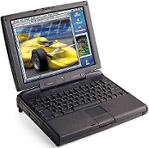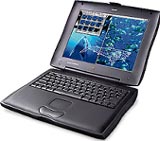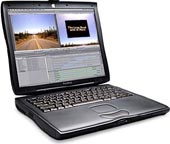Hosted by site sponsor WebMate.
PowerBook G3 Q&A - Updated January 12, 2010
To be notified of new Q&As, sign up for EveryMac.com's bimonthly email list.
How many different lines of PowerBook G3 models are there? What are the major differences between each PowerBook G3 line compared to one another?
There are five distinct revisions of the PowerBook G3 series -- the "Original/Kanga" model, the "Wallstreet" models, the "PDQ" (Pretty Damn Quick) models, the "Bronze Keyboard/Lombard" models, and the "Firewire/Pismo" models.
 The PowerBook G3/250 (Original) uses a "boxy but good" case effectively identical to the one used by the PowerBook 3400 before it.
The PowerBook G3/250 (Original) uses a "boxy but good" case effectively identical to the one used by the PowerBook 3400 before it.
Externally, it's the only PowerBook G3 to have a rainbow Apple logo on the back "lid". It has a small rainbow Apple logo visible under the display when open too.
Internally, it has a 250 MHz processor on a 50 MHz bus and onboard ADB, serial, and SCSI ports, along with a standard 1.44 MB floppy disk. The "swappable" bays are not compatible with other PowerBook G3 models.
 The "Wallstreet" models -- the PowerBook G3/233 (Wallstreet), G3/250 (Wallstreet), and G3/292 (Wallstreet) -- as well as the "PDQ" models, which had fewer configuration options in an effort to fix supply chain problems in a "Pretty Damn Quick" manner -- the G3/233 (PDQ), G3/266 (PDQ), and G3/300 (PDQ) -- can be grouped retroactively as a single line.
The "Wallstreet" models -- the PowerBook G3/233 (Wallstreet), G3/250 (Wallstreet), and G3/292 (Wallstreet) -- as well as the "PDQ" models, which had fewer configuration options in an effort to fix supply chain problems in a "Pretty Damn Quick" manner -- the G3/233 (PDQ), G3/266 (PDQ), and G3/300 (PDQ) -- can be grouped retroactively as a single line.
Externally, these models use a sleek "curvy" case design considerably different than its predecessor and have a large white Apple logo on the back and a small rainbow Apple logo visible under the display when open.
Internally, these models have processors ranging from 233 MHz to 300 MHz on either 66 MHz or 83 MHz buses (the PDQ models only have 66 MHz buses), also with onboard ADB, serial, and SCSI, along with a standard 1.44 MB floppy disk (later configurations began to phase out the floppy). The swappable bays are not compatible with earlier or later PowerBook G3 models.
 The "Bronze Keyboard" models (as Apple officially calls them, but users are more likely to call them "Lombard" referring to their code name) -- the PowerBook G3/333 and G3/400 -- look similar to the "Wallstreet" series before them.
The "Bronze Keyboard" models (as Apple officially calls them, but users are more likely to call them "Lombard" referring to their code name) -- the PowerBook G3/333 and G3/400 -- look similar to the "Wallstreet" series before them.
However, these models have brown translucent keyboards, a large white Apple logo on the back and a large white Apple logo above the display when open.
Internally, these models have 333 MHz or 400 MHz processors on a 66 MHz system bus and onboard SCSI and USB (but no ADB or serial support or a 1.44 MB floppy). If it has the "odd ball" combination of SCSI and USB, it's a Lombard.
It also has 8 MB of video RAM, at least twice that of earlier models. The swappable bay is not compatible with earlier models, but modules are compatible with the subsequently introduced "Firewire/Pismo" line.
 The "Firewire" -- as Apple formally calls the line -- or "Pismo" -- again referring to its codename -- is the fifth and final revision of the PowerBook G3 series and consists of the PowerBook G3/400 (Firewire/Pismo) and G3/500 (Firewire/Pismo).
The "Firewire" -- as Apple formally calls the line -- or "Pismo" -- again referring to its codename -- is the fifth and final revision of the PowerBook G3 series and consists of the PowerBook G3/400 (Firewire/Pismo) and G3/500 (Firewire/Pismo).
This series uses effectively the same case design as the "Lombard" series before it, but is labeled simply "PowerBook" under the display. Externally, it can easily be spotted by its Firewire ports. It has onboard USB as well.
Internally, these models have 400 MHz or 500 MHz processors on a 100 MHz system bus as well as AirPort (802.11b) support. The swappable bays is the same size as the one in the "Lombard" models, but due to logic board differences, modules compatible with the "Pismo" series are not necessarily compatible with the "Lombard" line.
Please refer to the Ultimate Mac Comparison feature to dynamically compare any PowerBook G3 model to any other G3 or later Mac.
Permalink | Report an Error/Typo | Sign Up for Site Update Notices
Established in 1996, EveryMac.com has been created by experts with decades of experience with Apple hardware. EveryMac.com includes, and always has included, original research incorporating detailed, hands-on inspection of packaging, computers, and devices as well as extensive real-world use. All information is provided in good faith, but no website or person is perfect. Accordingly, EveryMac.com is provided "as is" without warranty of any kind whatsoever. EveryMac.com, and the authors thereof, shall not be held responsible or liable, under any circumstances, for any damages resulting from the use or inability to use the information within. For complete disclaimer and copyright information please read and understand the Terms of Use and the Privacy Policy before using EveryMac.com. Copying, scraping, or use of any content without expressed permission is not allowed, although links to any page are welcomed and appreciated.
